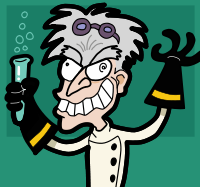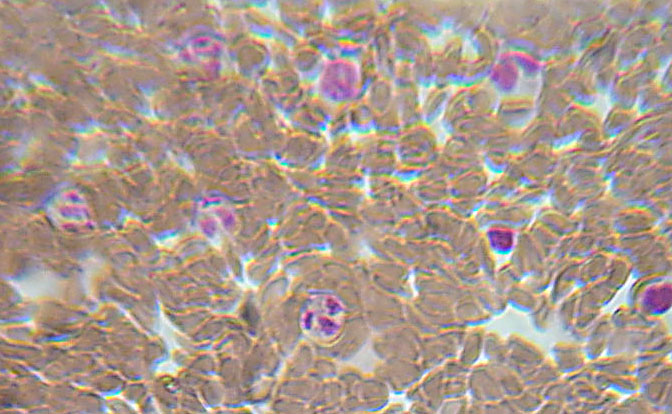The Neurocenter of Unige and L'Hopital Cantonal de Genève (HUG) will hold during the International Week of the brain and workshops visits to laboratories conducting research on various aspects of the brain and its functioning. We know how such visits can have a motivation for students, especially when prepared - With questions for example. They can also help students in their choice for their studies. They also allow students to get an idea of what the researcher discovered that they are not necessarily men and they do not all have thick glasses or a cap screw on the head .. . an image that would not want to follow this career!
Fig 1: The archetypal mad scientist: male and crazy ... After we are astonished at the lack of interest including science by women. While the outreach program is not yet published the inscriptions for activities with students are already open. Up I Feb. 18, but the activities are filling fast enough .... Brochure for schools brain International Week International Week of the brain is an annual information campaign aimed at attracting the attention of everyone on the importance of the brain and Brain Research. It will take place simultaneously in many countries around the world, from 14 to 20 March 2011. To mark this event , open doors for students and teachers are organized by the Interfaculty Centre for Neuroscience Fig 2: Week of brain 2011: Registration is open. [Img ] Source: Neurocenter
As last year, two different formulas are available for classes:
- Research Workshop (1h30) Students address realistically the various stages of research. They try to solve a problem by developing a scientific experiment and analyzing experimental data with the help of a researcher. A laboratory tour is also planned during the workshop. The work is designed specifically for college students but uses real scientific data. Please note that some workshops, students should bring a calculator.Please check with the person responsible for registrations. Visit
- laboratory (duration 45 min) As in previous years, different laboratories welcome classes to present their research and illustrate them through demonstrations.
- any further questions, please contact Mona Spiridon, tel: 022 379 5378, email: @ mona.spiridon unige.ch
More ...
 Listings:
Listings: Virginie.Sterpenich @ unige.ch tel: 022 379 58 73
How does our brain perceives it faces?
More ... Location: University Medical Center Ave. 9 champel
Listings: Yann.Cojan @ unige.ch
tel: 022 379 59 79
Can we predict our mistakes by measuring brain activity?
 More ...
More ...
Location: University Medical Center Ave. 9 champel
Listings:
Juliane.Britz @ unige.ch
tel: 022 379 57 28 Can we observe the development of new connections between nerve cells?
More ...
Location: University Medical Center Ave. 9 champel Listings:
Mathias.DeRoo @ unige.chtel: 022 379 54 33
How does one come to touch his nose in the dark? Sensitivity is poorly understood: proprioception. More ...
Location: Uni Mail, Boulevard du Pont d'Arve 40
Listings:
Clara.James @ unige.ch
| | Why smokers feel much they difficult to refrain from smoking? | More ...
| Listings: Joel.Billieux @ unige.ch | tel: 022 379 93 44 Our emotions play a role in our ability to inhibit an automatic response? | More ...
| Listings: Sebastien.Urben @ unige.ch | tel: 022 379 90 85 reasoning and its pitfalls: when everyone errs in being sure of being right | More ...
| Listings: Caroline.Gauffroy @ unige.ch | tel: 022 379 92 54 How to identify a stem cell in the nervous system? | More ...
| Listings: John Marc.Matter @ unige.ch | tel: 022 379 67 95 |
| VISIT LABORATORY (duration 45min) | Architecture human brain More ... Location: University Medical Center Ave. 9 champel |
| Antonia.Skrzat @ unige.ch tel: 022 379 53 48 | The brain is able to change at any time of life? More ... Location: Uni Mail, Boulevard du Pont d'Arve 40 |
| Celine.Buerki @ unige.ch tel: 022 379 93 03 | Working memory 8 to 88 years More ... Location: Uni Mail, Boulevard du Pont d'Arve 40 |
| Delphine.Fagot @ unige.ch tel: 022 379 92 26 | Pheromones and behavior: a question of receivers More ... Held Sciences III, Quai Ernest-Ansermet 30 |
| Chen-Da.Kan @ unige.ch tel: 022 379 31 February | imaging of anatomy and functioning of the brain More ... Location: HUG, Rue Gabrielle Perret-Gentil 4 |
Francois.Lazeyras @ hcuge.ch
The origins of knowledge
LDES will celebrate its 30 year history! ... ... already in the service of learning. Of course for the appropriation of scientific and technological knowledge, and by extension, the environment, health and citizenship, but not only ... The
November 30, 2010,
- at 18:15 / UniMail, room MR080.
30 Years / November 30, 2010 - 6:15 p.m. / UniMail room MR080
- If you are in Geneva and available, we hope you can join us for this moment and sympathetic to the Verrees to follow.
- If you're available, we hope you can join us for this moment for the friendly and Verrees to follow. desired response from Catherine Hulda PAHUD Falcy pahudfa at etu.unige.ch
- André Giordan
- experimental blog about the evolution of biology. To explore how we could keep alive the link between research and teaching.

 Barrie-tao
Barrie-tao  Despite the intense debates that led to its inception, quantum mechanics has quickly proven to be an extremely effective tool to understand and predict a host of new phenomena. Its success was such that it is quickly out of research labs to enter the field of everyday life. For example, it allowed us to understand why some materials are insulators, while other drivers and has made possible the discovery of transistors, which are the foundation of modern electronics. It helped to understand why some superconducting materials had the surprising property of carry current without loss, paving the way for advancements in medical imaging in the field of energy. Other consequences of this theory led to the realization of atomic clocks so precise that they will not earn any more than fifteen seconds of error since the beginning of the universe, and have resulted design and implementation of GPS positioning system satellite.
Despite the intense debates that led to its inception, quantum mechanics has quickly proven to be an extremely effective tool to understand and predict a host of new phenomena. Its success was such that it is quickly out of research labs to enter the field of everyday life. For example, it allowed us to understand why some materials are insulators, while other drivers and has made possible the discovery of transistors, which are the foundation of modern electronics. It helped to understand why some superconducting materials had the surprising property of carry current without loss, paving the way for advancements in medical imaging in the field of energy. Other consequences of this theory led to the realization of atomic clocks so precise that they will not earn any more than fifteen seconds of error since the beginning of the universe, and have resulted design and implementation of GPS positioning system satellite. 



